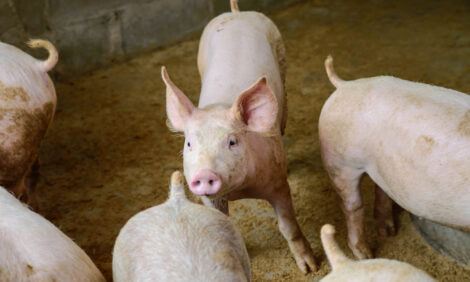



Have we started turning the corner on pork demand?
CANADA - Jim Long's Weekly Pork Commentary this week looks at the 35% improvement in last week's national average price compared to last August's average. Jim Long President, Baconmaker Genetics / Wood Lynn Farms, Inc. |
USDA slaughter last week was 1.805 million head and almost matched year ago's 1.806 million. Because hog weights are running 3 lbs heavier this year than last year, pork production last week exceeded year ago. Even so, prices last week trounced the average price in August of last year.
| Last Week | Average Last August |
| $57.57 | $42.53 |
Last week's national average price was 35% higher than last August's average. The improvement amounts to a $27 difference on the average market hog. Have we started turning the corner on pork demand?
Last year in August USDA 185-lb carcass cut outs averaged 52.84 cents. Last Friday they were 64.68, 22% higher than last August's average.
Cattle prices have been near 80 cents/lb live weight. So despite the price increase in hogs this year the spread between hog and cattle prices is as wide as it ever gets. Question is, has increased pork demand increased hog prices? Or has the high price of beef been dragging pork prices up? We expect it is some of both but we are optimistic that the main driver is real pork demand.
However....fall's seasonal increase in the supply of hogs and pork looms
The downside of seasonal reproductive successes nearly a year earlier, slaughter volume increases seasonally in the fall. Last year is a good example. During the last 2 weeks of last August, USDA weekly slaughter averaged almost 2 million head. That was 10% more than present slaughter levels. But we don't expect this year's seasonal increase to match last year's because of the data showing consistently lower pig crops since January.
Producers could use a fall that is less adverse than normal. The unfortunate reality is we are in an industry where little, if any, money has been made by producers for over 20 months. Trading dollars is not making anyone financially or emotionally stronger. The on going toll of this situation continues to be challenging. It not only enhances liquidation, it's been instrumental in severely limiting new barn construction. As the swine industry infrastructure ages, some facilities (along with their operators) are sidelined by obsolescence. The natural optimism of the producer has been shaken and the entrepreneurial spirit has been dampened.
Bottom line: We are seeing better demand and fewer hogs near term. Farrow-to-finish producers could lose money this fall but not on the grand scale of last year. We are optimistic. The smaller pig crops over the last 5 months that have averaged 80,000 fewer hogs/week than year ago gives us hope. We expect the corn and soy bean crop will be large enough to keep feed prices low. The U.S. breeding herd is at the lowest level in modern times and is still getting smaller. This will all lead to higher prices with competitive costs. An industry that has been hammered needs and deserves better times. Let the good times roll. Sooner would be better than later.
Mad Cow (BSE) Update
On Friday U.S. Secretary of Agriculture Veneman announced the U.S. would begin issuing import permits for Canadian boneless beef from cattle under 30 months of age. Acceptable beef will begin to enter the U.S. around September 1. Some points:
Live Canadian cattle cannot enter the U.S. This will force market and feeder cattle to stay in Canada. This will be good for Tyson and Cargil, the two major cattle slaughterers in Canada.
Beef from cattle over 30 months of age cannot be exported to the U.S. All cull cows' meat will have to be consumed in Canada. This should be good for the costs of hamburger chains.
Only boneless beef is acceptable to the U.S. This puts a crimp on export of t-bones, prime ribs etc.
The price of slaughter cattle in Canada should increase due to partial accessibility to the U.S. market. The increase will, in all likelihood, still leave Canadian cattle prices significantly below U.S. prices. The amount of Canadian beef still needing to be consumed at home requires lower prices to keep product moving.
The question for Canadian cattle producers is when will the U.S. accept live cattle and what is the Canadian government going to do for financial aid going forward. The producers have a step but the path into the future is still treacherous.
At the beginning of the Canadian ad cow crisis May 20, we speculated the border would be closed 90-120 days. It's still closed to live cattle.
In the last few weeks approximately 20,000 additional Canadian market hogs/week were exported to the U.S. than normal. Competition with a glut of stay-at-home Canadian beef lowered Canadian pork prices and more Canadian pork has migrated to the higher U.S. market. We expect the increased migration of Canadian hogs and pork to the U.S. market to stay where it it is until beef actually begins to go to U.S. Afterwards, export hog numbers should decline.
Though Veneman's announcement is a victory for the Canadian cattle industry, the short term and long term consequences of Canada's mad cow problem are still to be determined. Major banks in Canada are indicating reluctance to finance not only cattle, but hog accounts unless you're gold plated. Both Canadian cattle and hogs have major dependence on export markets. Cattle and beef exports 70% of production, hogs and pork exports 45% of production. When 1 cow in 1 herd on 1 farm shuts down an industry with billions of dollars of exports a year, it makes the banker quite nervous. We expect finding new capitalization for Canadian hog and cattle operations will be daunting in the foreseeable future, ending the 4-year expansion of the Canadian breeding herd.
| Published with permission from |
Information provided by |
Source: Jim Long, www.baconmaker.com. Reproduced courtesy Farms.com - 11th August 2003








